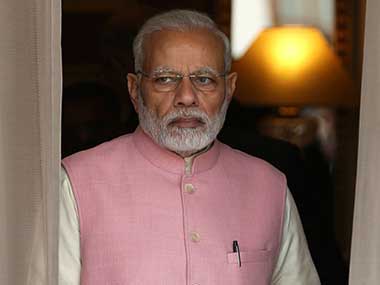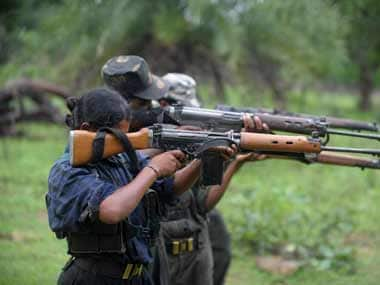As Narendra Modi govt completes 4 years, internal memo describes how bureaucracy derailed major projects
The past 48 months were marked by some historical decisions including demonetisation, the launch of Prime Minister Narendra Modi's medicare scheme, and the implementation of Goods and Service Tax — India's biggest tax reform since Independence. But there is uneasiness in the top echelons of the government over paralysis in the implementation of big-ticket infrastructure projects, which has much to do with the gridlock in the bureaucratic chain.

Though Prime Minister Narendra Modi has initiated a system of regular stocktaking of the schemes, lengthy inter-ministerial consultations as well as resolving clearance issues with the stakeholders seem to have contributed in slowing down the pace on the ground. During his address at Civil Services Day on 21 April, Modi indicated that the system needs to evolve as files even after traveling 32 times failed to get 'moksha'.
According to the latest government report, projects costing over Rs 150 crore in atomic energy, railways, and heavy industry are facing delays. In the atomic sector, all four projects were plagued by UPA's policy paralysis.
In fact, a project for fast breeder reactor at Bhavini was approved by the Atal Bihari Vajpayee government in September 2003 with an expenditure of Rs 3,492 crore and it was expected to become operational by September 2010. The project not only missed the deadline, the cost overrun is colossal and after spending Rs 5,566 crore, the government is expecting to complete the project by June this year and its cost to the national exchequer is supposed to go up to Rs 6,100 crore.
Two other atomic power projects — Kakrapar and Rajasthan — approved in October 2009 missed the original deadline of December 2015 and December 2016, respectively, and could become operational only in late 2019 and 2020. Also, the Kudankulam Nuclear Power Project that was approved by the Manmohan Singh-led UPA government in March 2013 will not be able to meet the November 2020 deadline; the Modi government expects to make it operational towards the end of 2023.
The government report said that the delay in these four nuclear projects alone would have a cost overrun of Rs 2,608 crores. According to government figures, about 264 projects were delayed while only 14 could manage to move ahead of schedule. Though 308 projects are on the right track of completion as mentioned at the time of clearance, the report in February 2018 stated that there are as many as 603 projects that do not have a time frame for completion.
So far a power project in Chhattisgarh, an Urban Development Ministry project in Madhya Pradesh and three railway projects — Suratpura-Hanumangarh-SriGanganagar Gauge conversion, Ratnagarh-Bikaner Gauge conversion and Rohtak-Bhiwani doubling — has been completed, the report said.
A 50 MW wind power project first cleared in November 2011 with a cost of Rs 310 crore has been running behind the schedule. Though the Urban Development Ministry is implementing 38 mega projects, some of which were sanctioned during the UPA-I regime, the government report said that in certain projects, it could be delayed by 72 months.
In November 2017, the government had reviewed 1,283 projects that were being monitored. Of these, 302 projects were running behind their schedule and the cost overrun of these delayed projects was Rs 1.45 lakh crores. The telecommunication sector could bring a bit of fresh air for the government, as seven out of nine major projects would be completed in the year 2018.
Though, according to the government, a standing committee in each ministry has been set up for fixation of responsibility for time and cost overruns, it has been observed that due to environmental clearances, statutory clearances, land acquisition and security clearances, it is difficult to fix the responsibility on babus for delay in implementation on the ground.
The government in December 2017 had said that they were monitoring 380 mega projects each costing Rs 1,000 crores and above. The original cost of implementation of these 380 projects was Rs 11.96 Lakh crore and their anticipated completion cost was likely to be Rs 13.62 lakh crore, reflecting overall cost overruns of Rs 1.66 lakh crores.
Time, cost overruns vary with projects, claims minister
In January 2018, programme implementation minister Vijay Goel had told the Lok Sabha narrating various other reasons for the delay. Goel had told the Lower House of the Parliament that the time and cost overruns are project-specific and depend on a variety of technical, financial and administrative factors, and differ from project to project. The main reasons, he argued, for the increase in the cost of the project are under-estimation of the original cost, changes in rates of foreign exchange, the high cost of environmental safeguards and rehabilitation measures, spiraling land acquisition, shortage of skilled manpower, and changes in project scope.
The government in 2016 had constituted eight group of secretaries on eight sectors — transport and communications, energy and environment, health and sanitation, education and social development, commerce and industry, science and technology, governance and crisis management with a mandate to prepare a time-bound action plan and to monitor the implementation of ministries and departments.
As far as the main action plan for timely completion of mega projects is concerned, the government feels that it needs to apply rigorous project appraisal, setting up of revised cost committees in the ministries for fixation of responsibility for time and cost overruns; regular review of infrastructure projects by the concerned administrative ministries; and setting up of central sector projects coordination committees (CSPCCs) in the states under the concerned chief secretaries for removal of bottlenecks and for facilitating the speedy implementation of major projects.
The government also has a project monitoring group (PMG), which primarily focuses on resolving a variety of issues for large public projects through inter-ministerial meetings to remove implementation bottlenecks. The group ensured that at least 197 of the 273 mega power projects were cleared after its intervention and meetings with various departments to address a variety of issues.
A report in January 2018 said that 210 projects having 515 clearance issues with anticipated investment of Rs 9.34 lakh crores were under consideration. The government has also made technological intervention to fast-track projects. Since 75 key approvals from the Centre are required to set up new projects, it has made at least 67 services integrated through an online platform to track the delay in sanctions and ensure that they are taken up by an appropriate authority.
The government, it appears, should focus on what a group of secretaries had observed: "Scheme approval should be limited to objectives, total outlay, broad guidelines, measurable outcomes with timelines, expenditure phasing, and evaluation. Within these parameters, states to have the freedom to formulate projects in consultation with the Ministries.”
In order to streamline the budgetary process, challenges and priorities for reforms, the International Monetary Fund's South Asia Training and Technical Assistance Center (SARTTAC) had recently held meetings with key ministries in the social sector to identify and implement good international practices.
The documents accessed by Firstpost shows SARTTAC officials had held three meetings with the Department of Economic Affairs on 21 and 22 February, and 1 March 2018 to discuss the reform challenges. The SARTTAC team documents also reveal that it had held meetings with Ministry of Housing and Urban Affairs, Rural Development and Ministry of Health.
Citizen-centric governance gets thumbs up
The Central ministries in the last four years were able to overcome problems in handling public grievances and as per latest report finalised after a meeting on 9 February 2018, a majority of grievances followed the service delivery time frame. The rate of disposal of grievances for the Ministry of Water Resources is 98.55 percent. There are 200 pending grievances out of which four grievances are pending for more than one year and seven grievances are pending for 6-12 months.
The rate of disposal of grievances in the Ministry of Minority Affairs is 93.47 percent. There are 341 pending grievances out of which 21 grievances are pending for more than one year and 49 grievances are pending for 6-12 months. During the meeting, the ministry reported that most of the grievances were related to scholarship issues, however, it was observed that the pendency of more than one-year-old grievances was quite high. For the Ministry of Housing, the rate of disposal of grievances is 98.18 percent. There are 764 pending grievances out of which 13 grievances are pending for more than one year and 39 grievances are pending for 6-12 months.
The meeting held at Sardar Patel Bhawan made it clear that all the ministries should conduct a review of grievances regularly at higher levels and a grievance must be addressed within a period of maximum two months. There was also a directive issued to the ministries that a grievance should not be closed by merely transferring it to the attached subordinate or field office and the concerned government officers should give a reasoned reply for the closure of a grievance to the citizen.
Modi had repeatedly flagged ‘Minimum Government, Maximum Governance’ and that has been the most attention-grabbing government reform process eliminating several obsolete laws and using technology in public service delivery to bring transparency. The government was able to address all the 18 issues taken up for reforms. The latest was the plan for the government's exit from the air service sector by proposing to sell up to 76 percent stake in Air India.
In the social sector, reports reviewed by Firstpost shows that implementation has been encouraging for the government. For Pradhanmantri Awas Yojna-Gramin, states and Union territories had sanctioned over 74.48 lakh houses and completed more than 33 lakh by 31 March 2018. The government plans to construct 2.95 Crore houses by 2022. As far as the second phase of Pradhan Mantri Gram Sadak Yojana (PMGSY) is concerned, of the total target of 50,000 kilometres, the government has cleared over 32,000 kilometres road length and out of 1.63 lakh unconnected habitations taken up for the work, more than 1.30 lakh habitations were connected till February this year. Under Deendayal Antyodaya Yojana with an aim to empower the rural poor, a total 6.81 lakh self-help groups were financed in 2017-18, a considerable improvement from 2016-17 when 5.7 lakh such groups were promoted across the country.
Source-https://www.firstpost.com/india/as-narendra-modi-govt-completes-4-years-internal-memo-describes-how-bureaucracy-derailed-major-projects-4441973.html





















